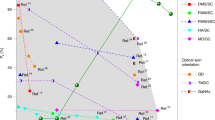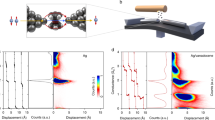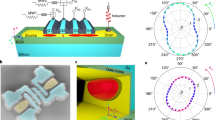Abstract
Generating, manipulating and detecting electron spin polarization and coherence at room temperature is at the heart of future spintronics and spin-based quantum information technology1,2,3,4. Spin filtering, which is a key issue for spintronic applications, has been demonstrated by using ferromagnetic metals5,6,7,8, diluted magnetic semiconductors9,10, quantum point contacts11, quantum dots12, carbon nanotubes13, multiferroics14 and so on. This filtering effect was so far restricted to a limited efficiency and primarily at low temperatures or under a magnetic field. Here, we provide direct and unambiguous experimental proof that an electron-spin-polarized defect, such as a Gai self-interstitial in dilute nitride GaNAs, can effectively deplete conduction electrons with an opposite spin orientation and can thus turn the non-magnetic semiconductor into an efficient spin filter operating at room temperature and zero magnetic field. This work shows the potential of such defect-engineered, switchable spin filters as an attractive alternative to generate, amplify and detect electron spin polarization at room temperature without a magnetic material or external magnetic fields.
This is a preview of subscription content, access via your institution
Access options
Subscribe to this journal
Receive 12 print issues and online access
$259.00 per year
only $21.58 per issue
Buy this article
- Purchase on Springer Link
- Instant access to full article PDF
Prices may be subject to local taxes which are calculated during checkout




Similar content being viewed by others
References
Wolf, S. A. et al. Spintronics: A spin-based electronics vision for the future. Science 294, 1488–1495 (2001).
Žutić, I., Fabian, J. & Das Sarma, S. Spintronics: Fundamentals and applications. Rev. Mod. Phys. 76, 323–410 (2004).
Awschalom, D. D. & Flatté, M. E. Challenges for semiconductor spintronics. Nature Phys. 3, 153–159 (2007).
Chappert, C., Fert, A. & Nguyen Van Dau, F. The emergence of spin electronics in data storage. Nature Mater. 6, 813–823 (2007).
Zhu, H. J. et al. Room-temperature spin injection from Fe into GaAs. Phys. Rev. Lett. 87, 016601 (2001).
Hammar, P. R. & Johnson, M. Detection of spin-polarized electrons injected into a two-dimensional electron gas. Phys. Rev. Lett. 88, 066806 (2002).
Jiang, X. et al. Highly spin-polarized room-temperature tunnel injector for semiconductor spintronics using MgO(100). Phys. Rev. Lett. 94, 056601 (2005).
Jonker, B. T. et al. Electrical spin-injection into silicon from a ferromagnetic metal/tunnel barrier contact. Nature Phys. 3, 542–546 (2007).
Fiederling, R. et al. Injection and detection of a spin-polarized current in a light-emitting diode. Nature 402, 787–790 (1999).
Ohno, Y. et al. Electrical spin injection in a ferromagnetic semiconductor heterostructure. Nature 402, 790–792 (1999).
Potok, R. M. et al. Detecting spin-polarized currents in ballistic nanostructures. Phys. Rev. Lett. 89, 266602 (2002).
Folk, J. A. et al. A gate-controlled bidirectional spin filter using quantum coherence. Science 299, 679–682 (2003).
Hauptmann, J. R. et al. Electric-field-controlled spin reversal in a quantum dot with ferromagnetic contacts. Nature Phys. 4, 373–376 (2008).
Gajek, M. et al. Tunnel junctions with multiferroic barriers. Nature Mater. 6, 296–302 (2007).
Meier, F. & Zakharchenya, B. P. Optical Orientation (North-Holland, 1984).
Weisbuch, C. & Lampel, G. Spin-dependent recombination and optical spin orientation in semiconductors. Solid. State. Commun. 14, 141 (1974).
Miller, R. C., Tsang, W. T. & Nordland, W. A. Spin-dependent recombination in GaAs. Phys. Rev. B 21, 1569–1575 (1980).
Paget, D. Optical-pumping study of spin-dependent recombination in GaAs. Phys. Rev. B 30, 931–946 (1984).
Kalevich, V. K. et al. Spin-dependent recombination in GaAsN solid solutions. JETP Lett. 82, 455–458 (2005).
Lombez, L. et al. Spin dynamics in dilute nitride semiconductors at room temperature. Appl. Phys. Lett. 87, 252115 (2005).
Lagarde, D. et al. Electron spin dynamics in GaAsN and InGaAsN structures. Phys. Status Solidi A 204, 208–220 (2007).
Buyanova, I. A. & Chen, W. M. Physics and Applications of Dilute Nitrides (Taylor & Francis Books, 2004).
Chen, W. M. Applications of optically detected magnetic resonance in semiconductor layered structures. Thin Solid Films 364, 45–52 (2000).
Baraff, G. A. & Schluter, M. Electronic structure, total energies, and abundances of the elementary point defects in GaAs. Phys. Rev. Lett. 55, 1327–1330 (1985).
Thinh, N. Q. et al. Properties of Ga-interstitial defects in AlGaNP. Phys. Rev. B 71, 125209 (2005).
Watkins, G. D. & Corbett, J. W. Defects in irradiated silicon. I. Electron spin resonance of the Si–A center. Phys. Rev. 121, 1001–1014 (1961).
Koh, A. K. & Miller, D. J. Hyperfine coupling constants and atomic parameters for electron paramagnetic resonance data. Atom. Data Nucl. Data Tables 33, 235–253 (1985).
Ohno, Y. et al. Spin relaxation in GaAs(110) quantum wells. Phys. Rev. Lett. 83, 4196–4199 (1999).
D’yakonov, M. I. & Kachorovskii, V. Yu. Spin relaxation of two-dimensional electrons in noncentrosymmetric semiconductors. Sov. Phys. Semicond. 20, 110–112 (1986).
Acknowledgements
W.M.C. and I.A.B. gratefully acknowledge the support from Linköping University through the Professor Contracts, the Swedish Research council (VR), the Swedish Energy Agency, the Knut and Alice Wallenberg Foundation, the Wenner-Gren Foundations and the Swedish Foundation for International Cooperation in Research and Higher Education (STINT). The work at UCSD is partially supported by NSF Grant No. DMR- 0606389.
Author information
Authors and Affiliations
Corresponding authors
Rights and permissions
About this article
Cite this article
Wang, X., Buyanova, I., Zhao, F. et al. Room-temperature defect-engineered spin filter based on a non-magnetic semiconductor. Nature Mater 8, 198–202 (2009). https://doi.org/10.1038/nmat2385
Received:
Accepted:
Published:
Issue Date:
DOI: https://doi.org/10.1038/nmat2385
This article is cited by
-
Spin-decoupling of vertical cavity surface-emitting lasers with complete phase modulation using on-chip integrated Jones matrix metasurfaces
Nature Communications (2022)
-
Room-temperature electron spin polarization exceeding 90% in an opto-spintronic semiconductor nanostructure via remote spin filtering
Nature Photonics (2021)
-
Effects of thermal annealing on localization and strain in core/multishell GaAs/GaNAs/GaAs nanowires
Scientific Reports (2020)
-
Annealing induced atomic rearrangements on (Ga,In) (N,As) probed by hard X-ray photoelectron spectroscopy and X-ray absorption fine structure
Scientific Reports (2018)
-
Room-temperature polarized spin-photon interface based on a semiconductor nanodisk-in-nanopillar structure driven by few defects
Nature Communications (2018)



